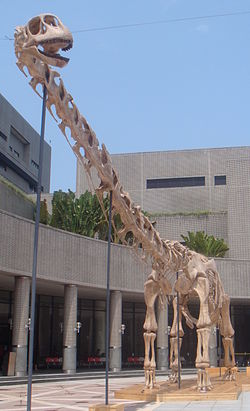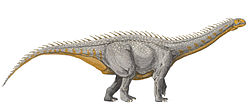| Daxiatitan Temporal range: Lower Cretaceous, | |
|---|---|
 | |
| Mounted skeleton cast | |
| Scientific classification | |
| Kingdom: | Animalia |
| Phylum: | Chordata |
| Class: | Reptilia |
| Clade: | Dinosauria |
| Clade: | Saurischia |
| Clade: | † Sauropodomorpha |
| Clade: | † Sauropoda |
| Clade: | † Macronaria |
| Clade: | † Titanosauria |
| Genus: | † Daxiatitan You et al., 2008 |
| Species: | †D. binglingi |
| Binomial name | |
| †Daxiatitan binglingi You et al., 2008 | |
Daxiatitan [a] is a genus of sauropod dinosaur known from the Lower Cretaceous of Gansu, China. Its type and only species is Daxiatitan binglingi. [b] It is known from a single partial skeleton consisting of most of the neck and back vertebrae, two tail vertebrae, a shoulder blade, and a thigh bone. At the time of its discovery in 2008, Daxiatitan was regarded as potentially the largest known dinosaur from China. [1]












